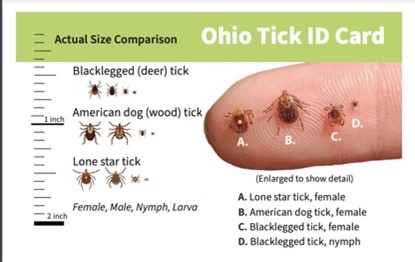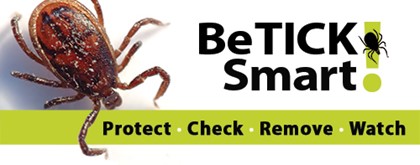Animal & Insects
According to the CDC, 75% of emerging infectious diseases come from animals. Recognizing this, Greene County Public Health works to protect the public from disease through surveillance, education, and control. The safety of the public and our staff is a priority for the Health District. To aid in identification, our Environmental Health inspection staff carry a photo identification card. We encourage, and our inspecting staff welcome, the public to ask to see their identification to prevent unauthorized access to a building, business, or home. No Health District personnel will ever treat an operator, business owner, or homeowner differently for asking for identification. Should someone arrive at your location and not be able to produce identification, please turn them away and call our office immediately.
Mosquitoes
Mosquitoes are a potential carrier of many diseases that affect humans, including Zika Virus, West Nile Virus, and La Crosse Encephalitis. The Greene County Public Health District conducts many activities to prevent mosquito-borne disease transmission, including observational community surveys, education/advertisements, larval mosquito surveillance and control, avian surveillance, adult mosquito surveillance and control, and human/animal disease surveillance.
Animals Bites/Rabies
Rabies is a viral disease spread by infected mammals, like bats, dogs, cats, ferrets, skunks, and raccoons. Humans that come in contact with a rabid, or potentially rabid animal, can also be infected. The result is death if left untreated. Recognizing the dangers associated with rabies, the Greene County Public Health District works to protect the public from the threat of rabies. This is performed by monitoring bite/exposure events, investigating exposures, prohibiting wild/exotic animals in the Health District, and requiring residents to vaccinate their pets against rabies.
Ticks
Ticks are a common pest in the outdoors of Ohio during the warmer months and can present a health hazard for both humans and their pets. While most ticks do not carry disease, the incidence of tickborne illnesses is increasing. Lyme disease is the most common tickborne illness in Ohio, with reported cases more than doubling between 2022 and 2023 (Ohio Department of Health). Understanding the risks associated with ticks and adopting preventive measures are crucial steps to take in protecting oneself and loved ones from potentially harmful infections.
Tickborne illnesses in Ohio
Different species of ticks are responsible for transmitting different diseases, so it is important to be able to identify a tick if you are bitten. In addition, it’s important to know how to properly handle a tick bite to lessen your chance for disease. Keep in mind that not all ticks carry disease, and handling tick removal properly can decrease the chance of disease transmission if a tick is a carrier.
This graphic from the Ohio Department of Health shows the three tick species you are likely to come across in Ohio, all of which have been found in Greene County.

These are the only vector of Lyme disease in the Midwestern United States, and can also carry diseases such as Powassan virus, Babesiosis and Anaplasmosis. Humans are most likely to be infected by immature Blacklegged ticks called nymphs. These nymphs are very small and are most active during the spring and early summer months, while the adults are most active in the spring and autumn. Adult ticks are also disease carriers but are more likely to be discovered and removed, because of their larger size. Blacklegged ticks are most commonly found in wooded areas.
American Dog ticks are the most common tick species in Ohio and can be found throughout the state. They are a vector for Rocky Mountain Spotted Fever, and prefer habitats with tall grass next to wooded areas. Dog ticks are most active during spring to mid-summer.
While not as common, these ticks are becoming more abundant in the Midwest. They carry Ehrlichiosis and ‘Stari’ borreliosis, as well as other diseases. Lone Star ticks are considered aggressive human biters, and all stages of the tick can be found throughout the warmer months. They are most likely to be found in shaded areas on the tips of tall grass or other low growing vegetation. The females have a white dot on their back making them easy to identify.
Tickborne disease is preventable!
The most important thing you can do to avoid a tick-borne illness is to prevent getting bitten by a tick. If you find an attached tick, the second most important thing you can do is to remove the tick as soon as possible, in a safe manner. Many tickborne diseases require the tick to be attached for 24 hours or more before disease transmission occurs, so early detection and removal of the tick can prevent infection in most cases.
Before going outdoors
- Clothing: Choose clothing that prevents ticks access to your skin. This means long sleeves and pants, hats, and shoes or boots and gloves if gardening. Tuck everything in if possible. Tuck pant legs into boots or socks and sleeves into your gloves. Wear light colors as ticks will be easier to see.
- Repellent: When doing activities that may put you in close contact with ticks it is a good idea to use a bug repellent that repels ticks. The US EPA has recommendations for effective repellents here. Make sure to always follow the directions on the label carefully.
Upon return
- Check clothing for crawling ticks. Take a shower and check your entire body for evidence of ticks. Pay close attention to areas around your head, ears, scalp, groin area, waist and under the arms. Check small children and pets that travelled with you, as well as any gear that you carried.
- Place clothing in the dryer for a minimum of 10 minutes on a high setting to kill any hitchhiking ticks. If clothes need to be washed first, use hot water if possible.
I found a tick on me. What should I do?
The CDC recommended way to remove a tick is to use pointed tweezers, grasp the tick as close to where it attaches to the skin as possible, and pull it straight out of the skin. Clean the area thoroughly after removal with rubbing alcohol or soap and water.

CAUTION: Do not use methods that require covering the tick with substances such as petroleum jelly or nail polish and then wait for the tick to “back out” of the skin. These methods can increase the chance of disease transmission. It is best to remove the tick in the manner described, as soon as possible to avoid risk of infection.
If you get a tick bite the CDC’s “Tick Bite Bot” is a helpful resource that can walk you through the steps to remove the tick and determine if a call to the doctor is recommended.
https://www.cdc.gov/ticks/communication-resources/tick-bite-bot-1.html
Remember, tickborne illnesses are preventable! The best way to prevent tickborne diseases is to prevent tick bites. In Ohio ticks are active year-round, but the most precaution is needed during the warmer months.
Additional resources:
CDC Fact Sheet Tick Bite: What to do?
Ohio Department of Health tick information and prevention Tickborne Diseases in Ohio
Ohio State University Extension Fact Sheet Ticks and Tick-Borne Diseases
Send in a photo for tick species identification through the University of Rhode Island’s Tick Encounter

